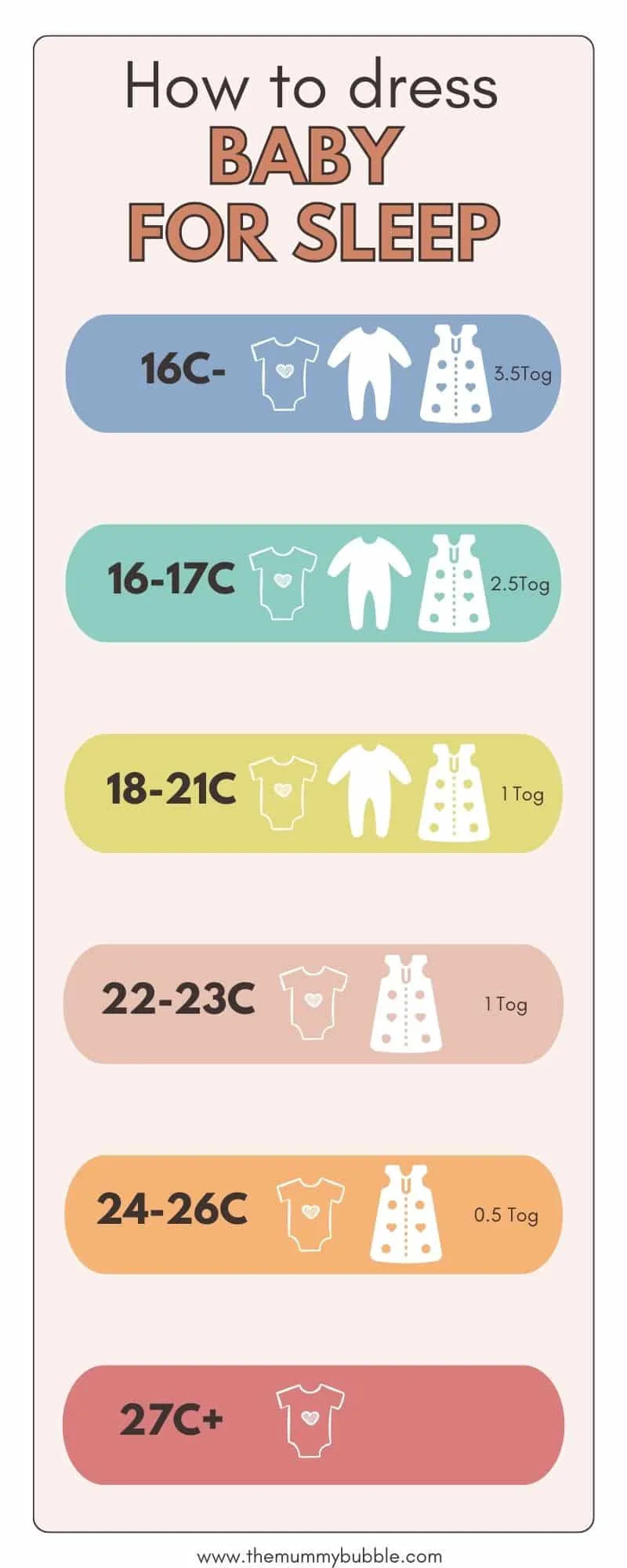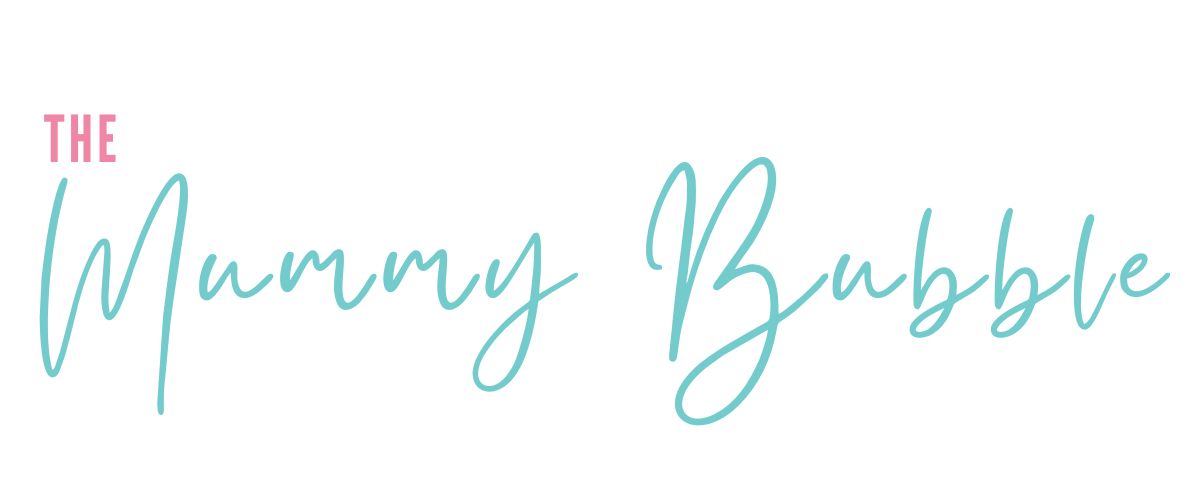Parenting is a steep learning curve and how to dress my baby for sleep was definitely one of the number one things I stressed about in the early days.
Whether it’s summer or winter, how many layers to dress your baby in and what type of blankets/how many to pop on top is a very common question for new parents.
Part of this issue is confidence. As first-time parents may second-guess themselves a lot when it comes to how you should be dressing your baby for sleep.
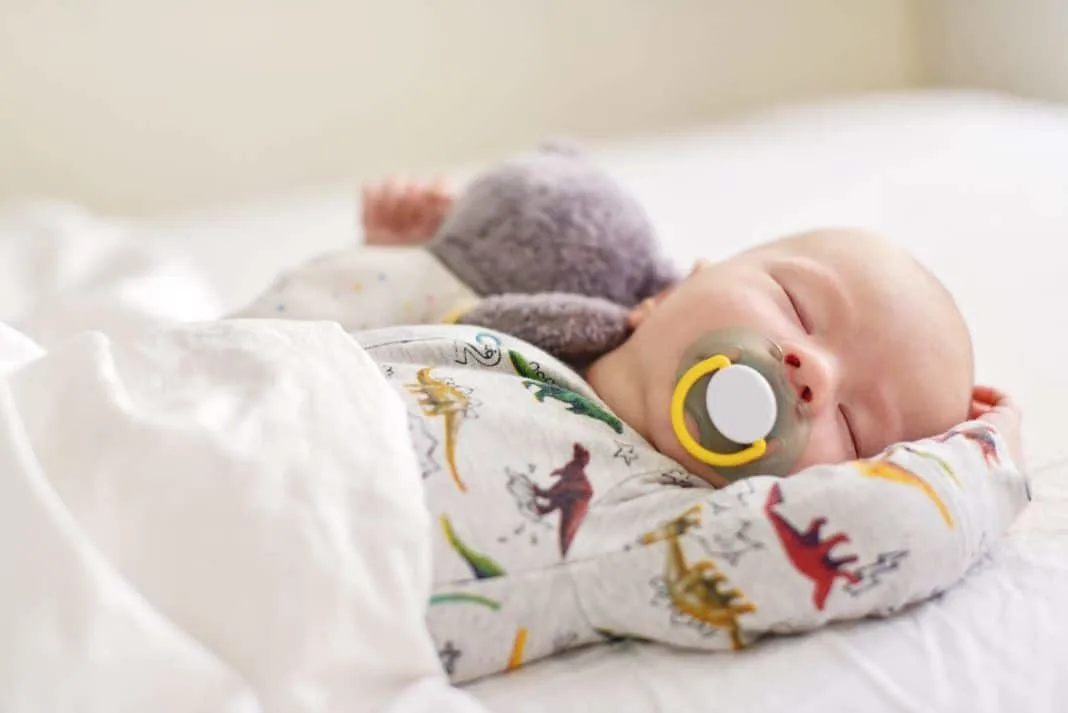
This is in part because the warnings about overheating are scary. And also because you can’t have a discussion with your baby about whether they’re comfortable or not.
It’s down to you to read their cues and monitor the room!
Thankfully there are now very clear guidelines and advice for parents on how to dress babies at night, plus super helpful baby products such as nursery thermometers and sleeping bags.
This post contains affiliate links
How to dress baby for sleep
The key tips to follow to make dressing baby for sleep super easy are:
- It all starts with knowing the temperature of the room. From here you can make the clothing decisions. Monitor the temperature using a nursery thermometer and then dress them accordingly.
- Start with a vest – also known as a bodysuit – and work your way up from there adding layers of lightweight clothing based on temperature. Just a vest for seriously hot summer nights, then add a sleepsuit (with long arms and legs) and blanket or sleep sack for normal or colder nights. At 16-20C (the ideal room temperature) baby should be in a vest, bodysuit and standard tog sleep sack, or one blanket.
- Check our handy guide setting out exactly what tog to use and what outfit to put on your baby depending on the temperature of the room. Many sleep sacks come with a guide like this for you to follow too. Once you know the room temperature, you can do clothing layers by numbers.
- Use baby sleeping bags, or sleep sacks, which are now made by a huge range of brands, including supermarkets. These come in a range of tog levels. So you can pick a thicker Tog 2.5 for winter and a very light 0.2 Tog for summer. Baby cannot kick these off in the night! I used the Grobag range for both of my babies and it honestly made it so easy. They’re suitable for babies from 7lbs in weight upwards.
- If you do not want to use sleeping bags, or your baby is too small to use one yet according to the manufacturers guidance on weight, then layer lightweight blankets. One light blanket is fine in summer, and two to three will keep them cosy in winter.
- Dress baby for the lowest temperature their room will hit overnight. This can help to avoid them waking because they have become cold. On warmer evenings I would put my babies down to sleep under a lightweight cellular blanket, then when I went to bed a few hours later add one more lightweight blanket to keep them warm through the night.
- Whatever bedding you use, lightweight fabrics are best, such as cotton. The NHS and sleep safety charities advise you do not use a duvet or pillow for a baby.
- In terms of clothing you’ll want to dress baby in a combination of bodysuits (sleeveless and legless vests that do up with poppers around the nappy) and sleepsuits (which are basically onesies that feature long sleeves and legs that cover the feet). In super cold weather your baby will wear a sleepsuit with bodysuit on underneath, but in very warm weather your baby may just need a bodysuit.
- You can swaddle your baby for the first two to four months of their life (before they start to roll over). The NHS advice is to not add any blankets to a baby who has already been swaddled.
- When it was particularly hot, for example 27C or warmer in their bedroom, I would simply put my babies down to sleep in just a nappy and cover them (up to the chest with blanket tucked under their arms) with a giant muslin.
We’re going to explore all of these tips in a little more detail in this article!
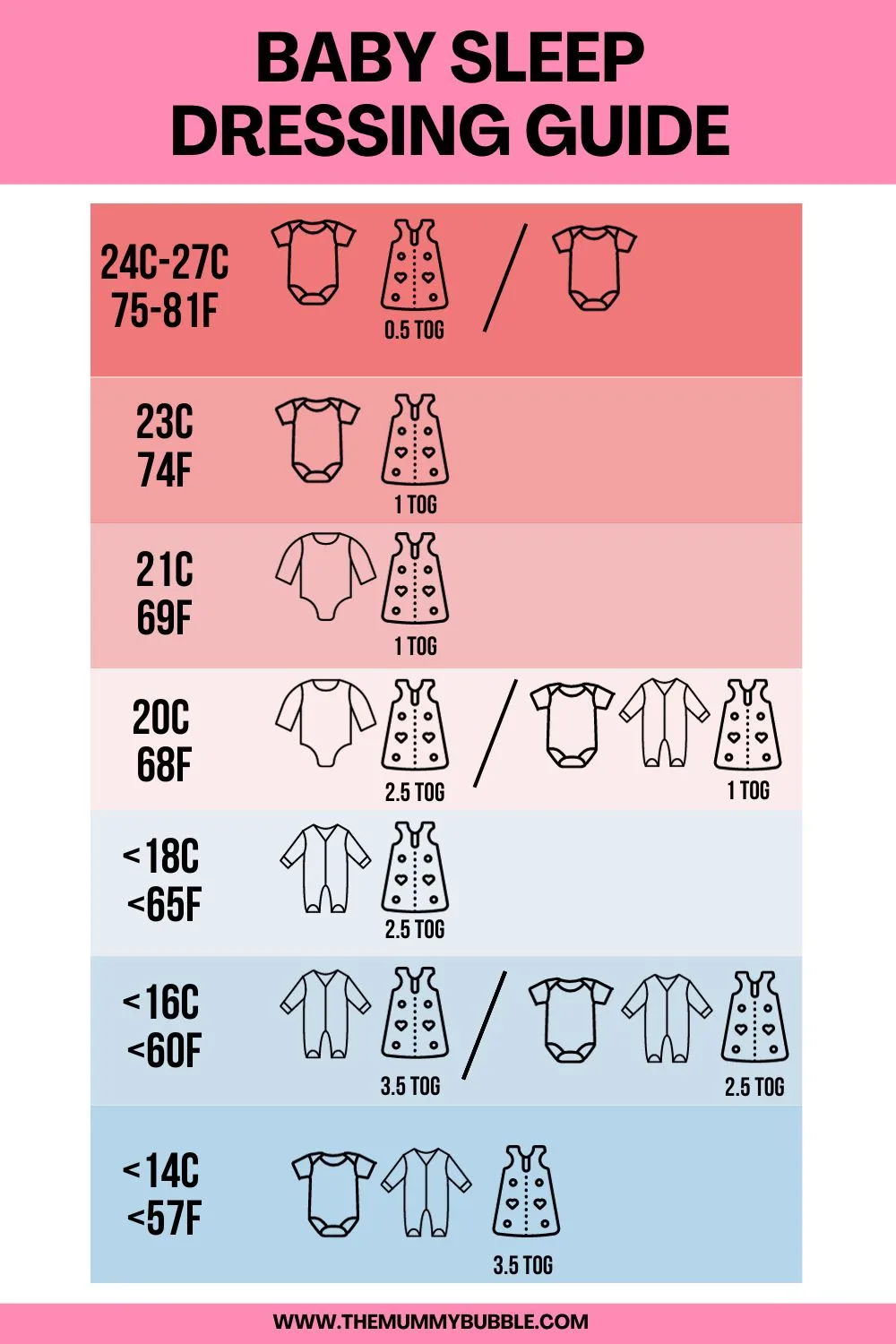
What clothes should babies wear to sleep?
Lightweight layers are key to dressing baby for sleep. It’s possible to overthink the clothes, but you can actually be guided a little by your own clothing.
So consider how many layers you are wearing to remain comfortable, then add one more layer for your baby.
When dressing a baby for sleep the advice is to mix and match the following items of clothing depending on the temperature:
- Sleepsuit (also known as a babygrow) – An all-in-one layer that is long-sleeved and full leg. These usually do up with poppers or a zip.
- Footless babygrow – These are great in comfy temperatures of around 17-21C. They are long-sleeved and cover the legs but leave the feet uncovered.
- Bodysuit – These come in both short and long-sleeved options. For sleep I always used the short sleeves and baby either wears it alone with a nappy in very hot temperatures, or underneath a sleepsuit in very cold temperatures. These usually fasten with poppers.
If you feel comfortable in the number of layers you are wearing, then your baby should be fine as well. So if you’re in a tee, with a jumper on top then putting baby down in a sleepsuit and bodysuit with a blanket on top will be fine.
When it comes to your baby’s hands these may feel cool, especially at winter, when they are asleep. This is not a cause for worry as your baby’s temperature should be tested by touching their chest or back.
You can read more about the best ways to keep baby’s hands warm at night here.
What type of bedding should you use?
When getting your baby’s crib or Moses basket ready use a firm mattress that is made to fit the bed, with no gaps around the edges, and a fitted cotton sheet.
A waterproof mattress cover is always handy to use underneath the sheet, as accidents do happen even with babies wearing a nappy!
You do not need cotbed bumpers or pillows, and the NHS advises these can actually be dangerous for babies.
The key bedding you will use to keep baby warm is:
- Sleeping bag (or sleep sack) – These fasten around your baby’s shoulders with zips or poppers. They can be easily opened up for nappy changes at night and prevent wriggly baby from kicking off the covers at night. Sleeping bags come in Tog ratings from 0.2 to 3.5. You’ll need to follow the manufacturer’s guide for weight as to when your baby can start to use a sleeping bag, however Grobag sell them suitable for babies from 7lbs in weight.
- Blankets – Choose blankets made from light-weight fabric. A blanket folded in half to cover baby counts as two layers, and if you fold it in half again that counts as four layers. In general you will use one to three blankets depending on the temperature. I personally always liked to use a combination of cellular blankets and fleece baby blankets (in winter) to keep my little ones comfy.
- Swaddle blanket – Many parents choose to swaddle their babies as it can help them to settle easier. You can buy pre-made swaddles that are easy to fasten around baby, or learn how to swaddle your baby in a normal baby blanket. Always use a light, cotton or muslin blanket to avoid baby overheating.
What temperature should baby’s room be?
Your baby’s room where they sleep should be 16 to 20C, according to the Lullaby Trust.
However we all know that controlling temperature in a house without air conditioning can be pretty tricky!
I used a GroEgg for both of my babies and I recall that many nights during the summer it would turn red with a sad face because the bedroom temperature had exceeded 25C.
So if you cannot always achieve this mythical ideal room temperature then do not panic! Follow the simple guidance in this article about how to dress your baby for any temperature!
What the NHS says about dressing baby for sleep
The NHS emphasises the importance of not allowing your baby to get too hot, as this can increase the risk of SIDS.
As parents we may also worry about our baby getting too cold, which could mean they are more likely to wake up due to discomfort.
All-night heating of the room where your baby is sleeping is rarely necessary, according to the NHS, and it’s easier to adjust the temperature by using layers of lightweight blankets.
So the key is lightweight layers in summer and winter that can be added and removed to adjust for temperature.
Baby sleeping bags, or sleep sacks, are also great and recommended by the NHS as a “good choice” as baby cannot kick the covers off like with blankets.
How to dress baby for sleep on cold nights
When putting a baby down to sleep in cold temperatures dress them in a long sleeve and full leg sleepsuit as well as a bodysuit (a vest with short sleeves and poppers that fix over the nappy) underneath.
You can then cover them with two to three blankets if it’s below 16C or a 2.5-3.5 Tog sleeping bag.
For cold temperatures here is a rough guide to what to dress your baby in:
- 16C or less – Sleepsuit, bodysuit (vest) and 3.5Tog sleeping bag or 2-3 blankets (one blanket folded in half to cover baby counts as two).
- 16-18C – Sleepsuit, bodysuit (vest) and 2.5Tog sleeping bag or two blankets.
How to dress baby for sleep on warm nights
In very hot temperatures you can put your baby down in just a nappy or with a bodysuit. You can pop a very light giant muslin on top of them if you’re worried they may become chilly in the night.
However during heatwaves houses can often stay in the mid 20C overnight.
When keeping your baby cool in a heatwave, you can gradually remove layers of clothing as well as the blankets, or reduce the Tog rating of your baby’s sleeping bag, to keep baby comfy.
For warmer temperatures here is a rough guide for how to dress your baby:
- 19-20C – Sleepsuit, bodysuit (vest) and 1Tog sleeping bag or one blanket.
- 20-24C – Sleepsuit and one blanket or 0.5Tog sleeping bag.
- 25C+ – Bodysuit and one blanket (no blanket if over 27C)
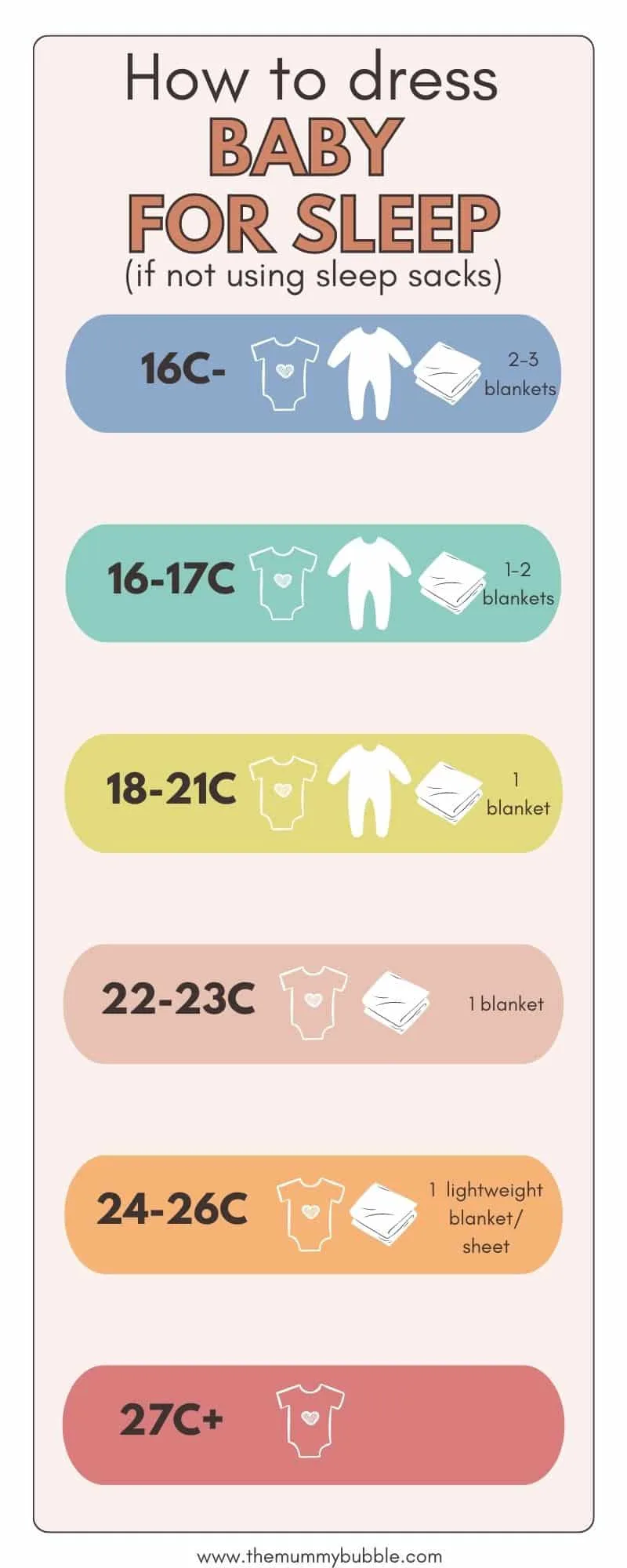
How to keep baby cool to sleep in summer
It can be tough to control the temperature of your baby’s bedroom in a heatwave.
Apart from following the above guidance for dressing them in the summer, you can also take a few steps to cool the room.
During the day open the windows first thing in the morning, when the temperature outside should be cooler. Once it starts to heat up outside (around 11am) then close the windows and the blinds or curtains to keep the heat of the day out.
Use a fan to help your baby feel comfortable, but monitor your baby to ensure they don’t get too chilly with the air blowing directly on them. A baby wearing just a nappy may get cold with a fan blowing directly on them, so putting them in a light bodysuit or covering them with a giant muslin can keep them comfy.
You can also try popping their bed sheets into a bag and placing that in the fridge for a few hours before putting them down to sleep. This can make it feel a little cooler for them when they are settling down for sleep.
A guide to sleep sack TOG ratings
Sleeping bags, or sleep sacks, are sold in different Tog levels, or warmth ratings.
The higher the Tog rating, the thicker the sleeping bag. A 0.2 Tog is extremely light.
Here’s a rough guide to which Tog rating to use for your baby depending on room temperature:
- 3.5 Tog – 14C or less
- 2.5 Tog – 14-20C
- 1 Tog – 20-24C
- 0.5 Tog – 24C or higher
How to tell if your baby is too hot or too cold
There are a few simple checks to follow at nap and bedtimes to ensure your baby’s comfort.
- Check the room temperature using a nursery thermometer.
- Dress your baby according to the temperature guide. You can check the guide in this article, or see the guide that is likely to be included with your baby’s sleeping bag (if you’re using one).
- Feel your baby’s chest and back of their neck. If your baby is too hot their skin will feel hot and slightly clammy. It is normal for their hands and feet to be cooler.
- A baby that is too hot may also have damp hair from sweating, flushed cheeks and rapid breathing.
- If baby is too hot then remove a layer.
- If the temperature has dropped and you think baby is cold then add another blanket.

Dressing baby for sleep dos and don’ts
Do
- Use thin muslin or a thin cotton sheet for swaddling baby.
- Do keep their head free of a swaddle.
- Use a room thermometer to help guide you – and check the temperature before you go to sleep in case you need to add or remove layers.
- Check your baby’s temperature before you go to sleep by putting your fingers to their chest (underneath their clothing) and back of their neck.
Don’t
- Put a hot water bottle or electric blanket into the crib with your baby.
- Place baby’s crib directly next to a radiator, heater or fire or in direct sunshine.
- Add blankets over a baby who is swaddled.
- Add a hat, as heat is released from the head as part of maintaining body temperature.
Final thoughts on how to dress your baby for sleep
We cannot temperature control the rooms that our babies sleep in, so we need to adjust what they wear to accommodate.
If you’re ever unsure about whether your baby is too hot in their pyjamas and bedding, touch the skin of their chest and back of their neck to see if they are sweaty and/or very hot.
Using lightweight blankets, or a Tog rating on a sleeping sack, makes your job much easier!
By the time my second baby arrived I was much more confident about what she should be wearing at night and nap times.

